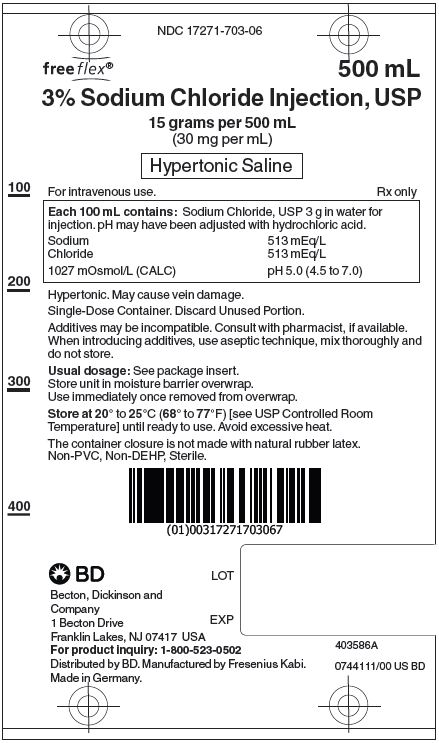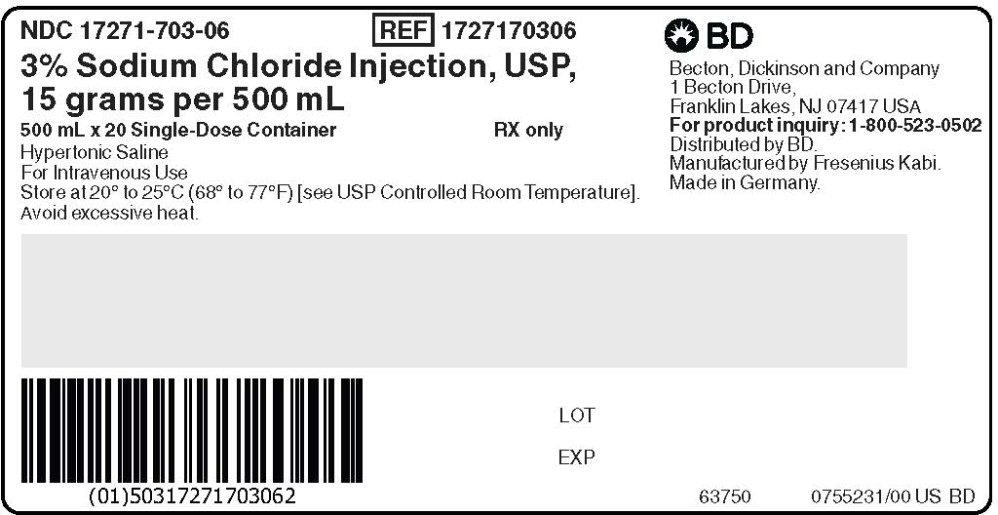DESCRIPTION:
3% Sodium Chloride Injection, USP is a sterile, nonpyrogenic, hypertonic solution for fluid and electrolyte replenishment in single dose containers for intravenous administration. The pH may have been adjusted with hydrochloric acid. It contains no antimicrobial agents. Composition, ionic concentration, osmolarity, and pH are shown in Table 1.
|
*Normal physiological osmolarity range is approximately 280 to 310 mOsmol/L. |
||||||
| Size (mL) | Composition
(g/L) | Ionic Concentration (mEq/L) | *Osmolarity
(mOsmol/L) (calc) | pH | ||
| Sodium
Chloride, USP (NaCl) | Sodium | Chloride | ||||
| 3% Sodium Chloride Injection, USP | 500 | 30 | 513 | 513 | 1,027 | 5.0 (4.5 to 7.0) |
The flexible container is fabricated from a specially formulated non-plasticized, film containing polypropylene and thermoplastic elastomers (freeflex® bag). The amount of water that can permeate from the container into the overwrap is insufficient to affect the solution significantly. Solutions in contact with the flexible container can leach out certain of the container's chemical components in very small amounts within the expiration period. The suitability of the container material has been confirmed by tests in animals according to USP biological tests for plastic containers.
CLINICAL PHARMACOLOGY:
3% Sodium Chloride Injection has value as a source of water and electrolytes. It is capable of inducing diuresis depending on the clinical condition of the patient.
INDICATIONS AND USAGE:
3% Sodium Chloride Injection is indicated as a source of water and electrolytes.
WARNINGS:
Hypersensitivity/infusion reactions, including hypotension, pyrexia, tremor, chills, urticaria, rash, and pruritus may occur with 3% Sodium Chloride Injection.
Stop the infusion immediately if signs or symptoms of a hypersensitivity reaction develop, such as tachycardia, chest pain, dyspnea and flushing. Appropriate therapeutic countermeasures must be instituted as clinically indicated.
Depending on the volume and rate of infusion, the intravenous administration of 3% Sodium Chloride Injection can cause fluid and/or solute overloading resulting in dilution of serum electrolyte concentrations, overhydration/hypervolemia, congested states, pulmonary edema, or acid-base imbalance. The risk of dilutive states is inversely proportional to the electrolyte concentration of the injection. The risk of solute overload causing congested states with peripheral and pulmonary edema is directly proportional to the electrolyte concentrations of the injection.
Monitor changes in fluid balance, electrolyte concentrations, and acid base balance during prolonged parenteral therapy or whenever the condition of the patient or the rate of administration warrants such evaluation.
Administer 3% Sodium Chloride Injection with particular caution to patients with or at risk for hypernatremia, hyperchloremia, hypervolemia or with conditions that may cause sodium retention, fluid overload and edema; such as patients with primary hyperaldosteronism, or secondary hyperaldosteronism (for example, associated with hypertension, congestive heart failure, liver disease (including cirrhosis), renal disease (including renal artery stenosis, nephrosclerosis) or pre-eclampsia). Certain medications may increase risk of sodium and fluid retention (see Drug Interactions).
Administer 3% Sodium Chloride Injection with particular caution to patients with severe renal impairment. In such patients administration of Sodium Chloride Injection may result in sodium retention.
PRECAUTIONS:
General
Do not connect flexible plastic containers in series in order to avoid air embolism due to possible residual air contained in the primary container. Such use could result in air embolism due to residual air being drawn from the primary container before administration of the fluid from the secondary container is completed.
Pressurizing intravenous solutions contained in flexible plastic containers to increase flow rates can result in air embolism if the residual air in the container is not fully evacuated prior to administration.
Use of a vented intravenous administration set with the vent in the open position could result in air embolism. Vented intravenous administration sets with the vent in the open position should not be used with flexible plastic containers.
3% Sodium Chloride Injection is hypertonic with an osmolarity of 1,027 mOsmol/L. Administration of hypertonic solutions may cause venous damage and thus should be administered through a large vein, for rapid dilution.
Do not mix or administer 3% Sodium Chloride Injection solution through the same administration set with whole blood or cellular blood components.
Rapid correction of hypo- and hypernatremia is potentially dangerous (risk of serious neurologic complications). Dosage, rate, and duration of administration should be determined by a physician experienced in intravenous fluid therapy.
Drug Interactions
Caution must be exercised in the administration of 3% Sodium Chloride Injection to patients treated with drugs that may increase the risk of sodium and fluid retention, such as corticosteroids.
Caution is advised in patients treated with lithium. Renal sodium and lithium clearance may be increased during the administration of 3% Sodium Chloride Injection. Administration of 3% Sodium Chloride Injection may, therefore, result in decreased lithium levels.
Pregnancy
There are no adequate and well controlled studies with 3% Sodium Chloride Injection in pregnant women and animal reproduction studies have not been conducted with this drug. Therefore, it is not known whether 3% Sodium Chloride Injection can cause fetal harm when administered to a pregnant woman. 3% Sodium Chloride Injection should be given during pregnancy only if the potential benefit justifies the potential risks to the fetus.
Nursing Mothers
It is not known whether this drug is excreted present in human milk. Because many drugs are excreted present in human milk, caution should be exercised when 3% Sodium Chloride Injection is administered to a nursing woman.
Pediatric Use
The use of 3% Sodium Chloride Injection in pediatric patients is based on clinical practice (see DOSAGE AND ADMINISTRATION).
Plasma electrolyte concentrations should be closely monitored in the pediatric population as this population may have impaired ability to regulate fluids and electrolytes.
Geriatric Use
Clinical studies of 3% Sodium Chloride Injection did not include sufficient numbers of subjects aged 65 and over to determine whether they respond differently from younger subjects. Other reported clinical experience has not identified differences in responses between the elderly and younger patients. In general, dose selection for an elderly patient should be cautious, usually starting at the low end of the dosing range, reflecting the greater frequency of decreased hepatic, renal, or cardiac function, and of concomitant disease or other drug therapy.
This drug is known to be substantially excreted by the kidney, and the risk of toxic reactions to this drug may be greater in patients with impaired renal function. Because elderly patients are more likely to have decreased renal function, care should be taken in dose selection, and it may be useful to monitor renal function.
ADVERSE REACTIONS:
Post-Marketing Adverse Reactions
The following adverse reactions have not been reported with 3% Sodium Chloride Injection but may occur:
- hyperchloremia
- hyperchloremic metabolic acidosis,
- hypersensitivity/infusion reactions, including hypotension, pyrexia, tremor, chills, urticaria, rash, and pruritus,
- Infusion site reactions, such as thrombosis, phlebitis, irritation, infusion site erythema, injection site streaking, burning sensation, infusion site urticaria.
If an adverse reaction does occur, discontinue the infusion, evaluate the patient, institute appropriate therapeutic countermeasures, and save the remainder of the fluid for examination if deemed necessary.
OVERDOSAGE:
Excessive administration of 3% Sodium Chloride Injection may lead to hypernatremia (which can lead to CNS manifestations, including seizures, coma, cerebral edema and death) and sodium overload (which can lead to central and/or peripheral edema).
When assessing an overdose, any additives in the solution must also be considered. The effects of an overdose may require immediate medical attention and treatment.
DOSAGE AND ADMINISTRATION:
As directed by a physician. Dosage, rate, and duration of administration are to be individualized and depend upon the indication for use, the patient's age, weight, clinical condition, concomitant treatment, and on the patient's clinical and laboratory response to treatment.
Parenteral drug products should be inspected visually for particulate matter and discoloration prior to administration whenever solution and container permit. Use of a final filter is recommended during administration of all parenteral solutions, where possible.
Do not administer unless solution is clear and seal is intact.
All injections in flexible plastic containers are intended for intravenous administration using sterile and nonpyrogenic equipment.
Additives may be incompatible. Complete information is not available. Those additives known to be incompatible should not be used. Consult with pharmacist, if available. If, in the informed judgment of the physician, it is deemed advisable to introduce additives, use aseptic technique. Mix thoroughly when additives have been introduced. Do not store solutions containing additives.
After opening the container, the contents should be used immediately and should not be stored for a subsequent infusion. Do not reconnect any partially used containers. Discard any unused portion.
HOW SUPPLIED:
3% Sodium Chloride Injection, USP in a single dose flexible plastic container, is available as follows:
| Product No. | 1727170306 | 1727170306 |
| Presentation | Single-Dose Container | Carton |
| NDC # | 17271-703-06 | 17271-703-06 |
| Description | 15 grams per 500 mL in a 500 mL bag (30 mg per mL) | 20 Single-Dose Containers in 1 Carton |
Exposure of pharmaceutical products to heat should be minimized. Avoid excessive heat.
INSTRUCTIONS FOR USE:
Check flexible container solution composition, lot number, and expiry date.
Do not remove solution container from its overwrap until immediately before use. Use sterile equipment and aseptic technique.
To Open
- Turn solution container over so that the text is face down. Using the pre-cut corner tabs, peel open the overwrap and remove solution container.
- Check the solution container for leaks by squeezing firmly. If leaks are found, or if the seal is not intact, discard the solution.
- Do not use if the solution is cloudy or a precipitate is present.
To Add Medication
- Identify WHITE Additive Port with arrow pointing toward container.
- Immediately before injecting additives, break off WHITE Additive Port Cap with the arrow pointing toward container.
- Hold base of WHITE Additive Port horizontally.
- Insert needle horizontally through the center of WHITE Additive Port's septum and inject additives.
- Mix container contents thoroughly.
Preparation for Administration
- Immediately before inserting the infusion set, break off BLUE Infusion Port Cap with the arrow pointing away from container.
- Use a non-vented infusion set or close the air-inlet on a vented set.
- Close the roller clamp of the infusion set.
- Hold the base of BLUE Infusion Port.
- Insert spike through BLUE Infusion Port by rotating wrist slightly until the spike is inserted. NOTE: See full directions accompanying administration set.
WARNING: Do not use flexible container in series connections.
Becton, Dickinson and
Company
1 Becton Drive
Franklin Lakes, NJ 07417 USA
For product Inquiry: 1-800-523-0502
Distributed by BD.Manufactured by
Fresenius Kabi.
Made in Germany.
451642
Issued: November 2019



